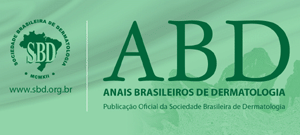Resumo em Português:
FUNDAMENTOS: As características do melanoma acrolentiginoso (MAL) diagnosticado no Brasil são pouco estudadas. OBJETIVOS: Avaliar as características do MAL diagnosticado na Unidade de Melanoma da Santa Casa de São Paulo - UMSC, comparando essa manifestação com outros subtipos e verificar se as possíveis diferenças entre eles teriam importância na determinação do diagnóstico, tratamento e prognóstico. MÉTODO: A Casuística da UMSC foi subdividida em dois grupos, um de melanoma acrolentiginoso (MAL) e outro de melanoma não acrolentiginoso (NAL), que foram comparados quanto a sexo, cor, idade, espessura e nível de invasão da lesão primária, estadiamento, tempo decorrido entre a percepção do tumor e o atendimento pelo médico. RESULTADOS: A casuística correspondente ao MAL mostrou freqüência significativa de pacientes não brancos, com faixa etária mais elevada, com a lesão primária em média, mais espessa e ulcerada. Não ocorreram diferenças significativas quanto ao sexo e estadiamento, bem como com relação ao tempo decorrido entre perceber a neoplasia e procurar o médico. CONCLUSÕES: O MAL diagnosticado na UMSC ocorre, principalmente, em pacientes que normalmente não são alertados para câncer da pele (não brancos) e pertencem a uma faixa etária mais elevada (portanto, do ponto de vista teórico, poderiam estar menos atentos ao início da doença). A maioria apresentou lesão espessa e ulcerada, conseqüentemente de maior risco para metástases. Essa forma de câncer é desconhecida do público em geral e mesmo por boa parcela da classe médica.
Resumo em Inglês:
BACKGROUND: The characteristics of acral lentiginous melanoma diagnosed in Brazil have been subject to few studies. OBJECTIVES: To evaluate the characteristics of acral lentiginous melanoma diagnosed at the Melanoma Unit of Santa Casa Hospital of Sao Paulo, to compare them with the other melanoma subtypes and to verify whether the possible differences between them are important in the determination of the diagnosis, treatment and prognosis. METHOD: Patients were divided into acral lentiginous melanoma and non-acral lentiginous melanoma groups and compared in reference to sex, color, age, depth and level of invasion of the primary lesion, stage, time between perceiving the tumor and seeking medical assistance. RESULTS: The cases of acral lentiginous melanoma were significantly more frequent among non-whites and the elderly, with the primary lesion, on average deeper and ulcerated, without significant differences in the sex, stage or the time elapsed between noticing the neoplasia and seeking the physician. CONCLUSIONS: Acral lentiginous melanoma diagnosed at the Melanoma Unit of Santa Casa Hospital of Sao Paulo, occurred mainly: in patients: who had not been advised about skin cancer (non-whites) and patients who are elderly and therefore, theoretically, could be less liable to notice the onset of the disease. The majority also presented deeper and ulcerated lesions and consequently with a higher risk of metastasis. This kind of cancer is unknown to the public in general and even to a large number of physicians.
